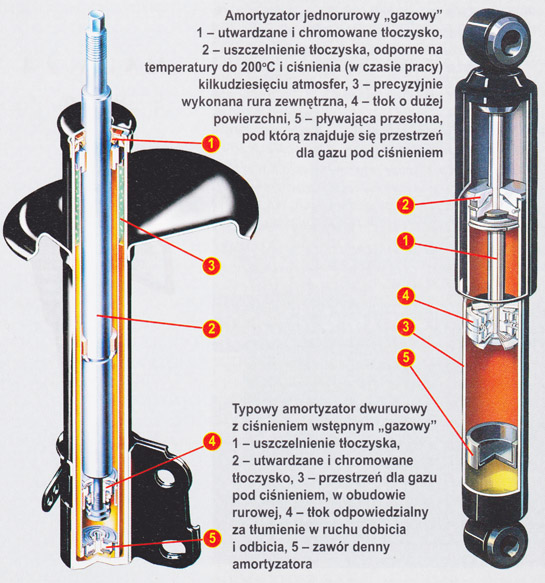 The principle of operation of a double-acting hydraulic shock absorber. The hull of the shock absorber is attached to the vehicle frame, Its lever is articulated via a rod (coupler) with the axle of the vehicle. In the body of the shock absorber there is a cylinder separated by a double piston, consisting of two connected pistons. There are key valves in the bottoms of the pistons, through which oil can flow while the pistons are moving, possibly supplementing its losses, The axle arm fits between the pistons, on the outer end of which a lever is seated, connected by a pull rod (stick) with the axle or wheel of the vehicle. There are two channels in the hull of the shock absorber, connecting the cylinder spaces on both sides of the pistons, in which the valves are placed: the stress movement and the relaxation movement (pressure and backflow). The inside of the shock absorber is filled with liquid (with oil). The operation of the damper is as follows: in the event of a deflection of the spring, external lever of the shock absorber, connected by a rod to the axle of the car, moves up, which causes the double piston in the damper cylinder to shift to the right, which pushes the liquid through the channels from the right ventricle to the left. When the fluid pressure is low, the oil flows through the oblique cut of the pressure relief valve (feedback), when the pressure increases, in addition, the tensioning valve opens (pressure). When the spring is released, the axle arm moves the piston in the opposite direction and the liquid is pumped back from the left chamber to the right. At this time, the valve of the tensioning movement (pressure) is closing, and the fluid only flows through the relief valve (maneuverable). The valves are so adjusted, that the damping during spring bending is lower, and during its expansion, greater. Due to resistance, which the damper valves put on the flow of the liquid, the car's oscillations are quickly damped. This has a positive effect on both a comfortable ride for passengers and the stability of the car.
The principle of operation of a double-acting hydraulic shock absorber. The hull of the shock absorber is attached to the vehicle frame, Its lever is articulated via a rod (coupler) with the axle of the vehicle. In the body of the shock absorber there is a cylinder separated by a double piston, consisting of two connected pistons. There are key valves in the bottoms of the pistons, through which oil can flow while the pistons are moving, possibly supplementing its losses, The axle arm fits between the pistons, on the outer end of which a lever is seated, connected by a pull rod (stick) with the axle or wheel of the vehicle. There are two channels in the hull of the shock absorber, connecting the cylinder spaces on both sides of the pistons, in which the valves are placed: the stress movement and the relaxation movement (pressure and backflow). The inside of the shock absorber is filled with liquid (with oil). The operation of the damper is as follows: in the event of a deflection of the spring, external lever of the shock absorber, connected by a rod to the axle of the car, moves up, which causes the double piston in the damper cylinder to shift to the right, which pushes the liquid through the channels from the right ventricle to the left. When the fluid pressure is low, the oil flows through the oblique cut of the pressure relief valve (feedback), when the pressure increases, in addition, the tensioning valve opens (pressure). When the spring is released, the axle arm moves the piston in the opposite direction and the liquid is pumped back from the left chamber to the right. At this time, the valve of the tensioning movement (pressure) is closing, and the fluid only flows through the relief valve (maneuverable). The valves are so adjusted, that the damping during spring bending is lower, and during its expansion, greater. Due to resistance, which the damper valves put on the flow of the liquid, the car's oscillations are quickly damped. This has a positive effect on both a comfortable ride for passengers and the stability of the car.